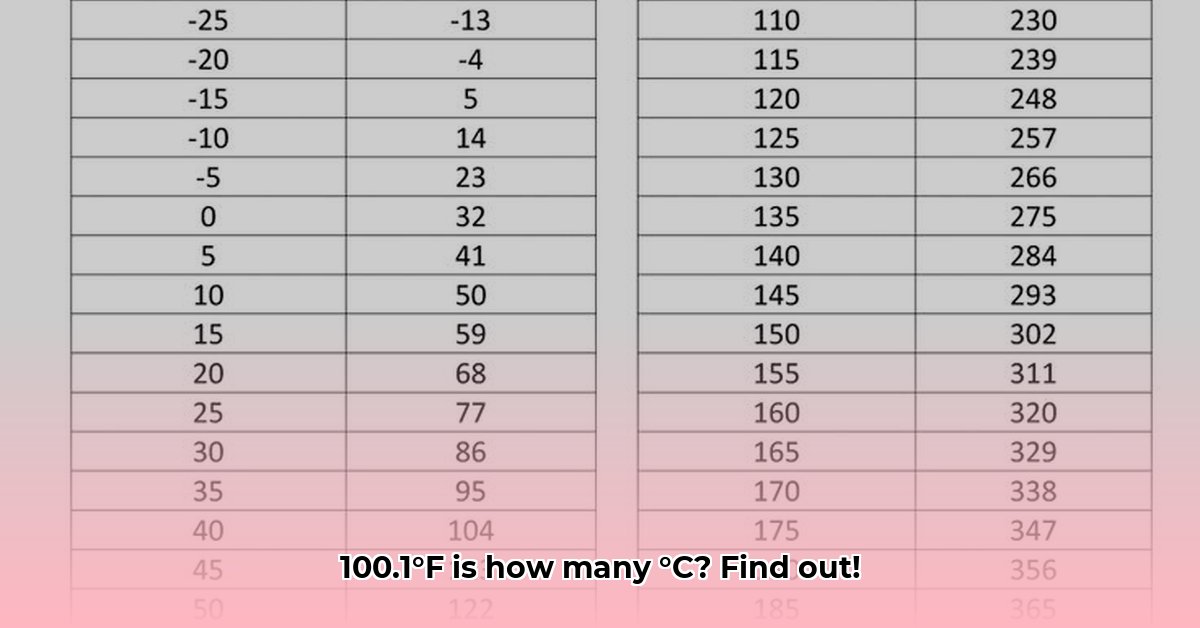100.1°F = 37.83°C
Quick Conversion & Understanding the Scales
This guide provides a quick Fahrenheit to Celsius conversion for 100.1°F, explains the conversion formula, and offers insights into the Fahrenheit and Celsius scales.
Conversion Formula and Calculation
The formula to convert Fahrenheit (°F) to Celsius (°C) is:
°C = (°F – 32) × 5/9
Let’s apply this to 100.1°F:
- Subtract 32: 100.1 – 32 = 68.1
- Multiply by 5/9: 68.1 × 5/9 = 37.83
Therefore, 100.1°F is equal to 37.83°C.
Fahrenheit and Celsius: Origins and Uses
-
Fahrenheit: Developed by Daniel Gabriel Fahrenheit in the early 18th century. Its zero point was originally based on the freezing point of a specific brine solution, and later adjusted. Water freezes at 32°F and boils at 212°F. Primarily used in the United States.
-
Celsius (Centigrade): Developed by Anders Celsius. Uses the freezing point of water (0°C) and boiling point of water (100°C) as its reference points. More widely used globally and is the standard for scientific measurements.
Temperatures Near 100.1°F
This table provides context for temperatures around 100.1°F:
| Fahrenheit (°F) | Celsius (°C) | Description |
|---|---|---|
| 99 | 37.22 | Comfortably warm |
| 100 | 37.78 | A touch warmer |
| 100.1 | 37.83 | Slightly above 100°F |
| 101 | 38.33 | Noticeably warmer |
| 102 | 38.89 | Quite warm |
Why Convert Temperatures?
Accurate temperature conversion is crucial in diverse situations:
-
Cooking: Recipes often specify temperatures in Celsius or Fahrenheit. Conversion ensures correct oven settings and cooking times.
-
Travel: Understanding local temperature scales (likely Celsius in most countries) is important for packing and planning activities.
-
Science: Celsius is the standard unit in scientific research, making conversion essential for accurate measurements and data interpretation.
-
Weather: Interpreting weather forecasts from different regions often requires converting between Fahrenheit and Celsius.
-
Industry: Many industrial processes require precise temperature control, and conversions are often necessary for operations and safety.
Beyond Fahrenheit and Celsius: The Kelvin Scale
The Kelvin scale is an absolute temperature scale used primarily in scientific contexts. Absolute zero (0 K) represents the theoretically lowest possible temperature, where all molecular motion ceases. Understanding the Kelvin scale and its relationship to Celsius and Fahrenheit can deepen your comprehension of temperature measurement.
FAQs: Common Temperature Conversion Questions
-
Why does the US still use Fahrenheit? Historical reasons and ingrained habits contribute to the continued use of Fahrenheit, despite Celsius being the global standard. This preference also likely stems from cultural factors and perceived benefits for daily temperature ranges. Further research might reveal additional societal influences.
-
Are there any drawbacks to using Fahrenheit? Some argue that the increments in Fahrenheit are less intuitive for daily life compared to the Celsius scale. The wider range between freezing and boiling points in Fahrenheit can also make quick estimations less straightforward. These are subjective observations, and further studies could explore the practical impact of scale differences on everyday use.
-
How precise are temperature conversions? Conversions using the standard formula provide a high degree of accuracy for most practical purposes. However, at very extreme temperatures, the relationship between the scales might exhibit slight variations depending on the specific measurement methods.
Further Exploration
- Celsius to Kelvin Conversion: Learn how to convert between Celsius and Kelvin.
- History of Temperature Scales: Explore the development of different temperature scales.
- Thermodynamics: Delve into the science of heat and temperature.
This comprehensive guide aims to provide a clear and concise overview of Fahrenheit to Celsius conversion, the underlying principles, and the practical relevance of understanding temperature scales. While we strive for accuracy, it’s important to acknowledge that scientific understanding is always evolving, and future research may refine our current knowledge of temperature and measurement.
- Bento Box Trays Streamline Restaurant Meal Presentation and Transport - December 13, 2025
- Plastic Bento Boxes Face Scrutiny Over Sustainability Impacts - December 11, 2025
- Bento Tray Revolutionizes Organized Meal Transport and Presentation - December 10, 2025










